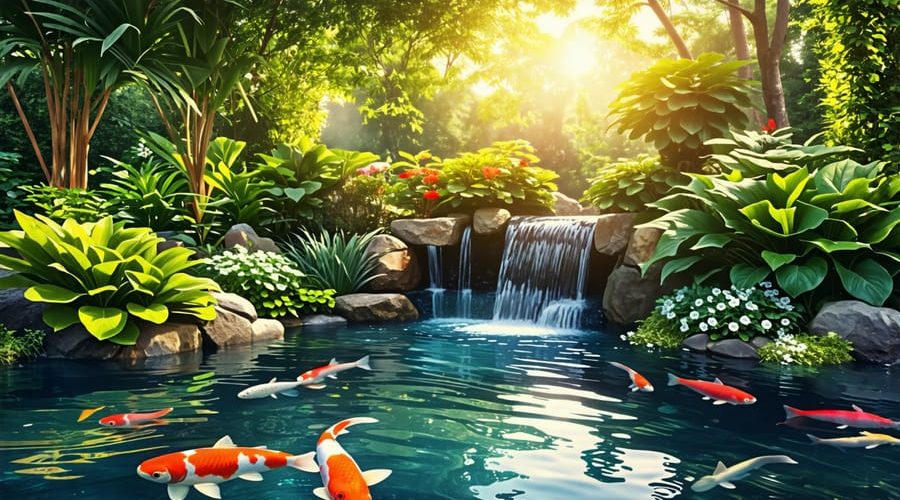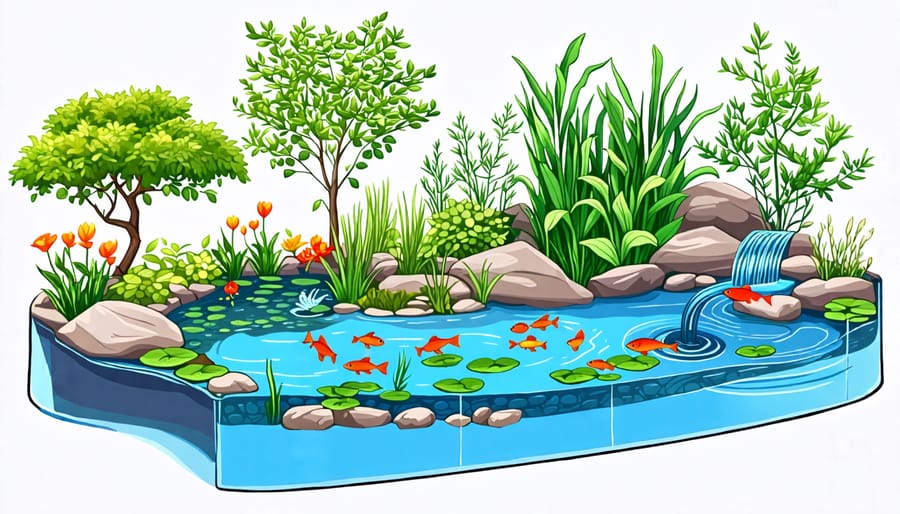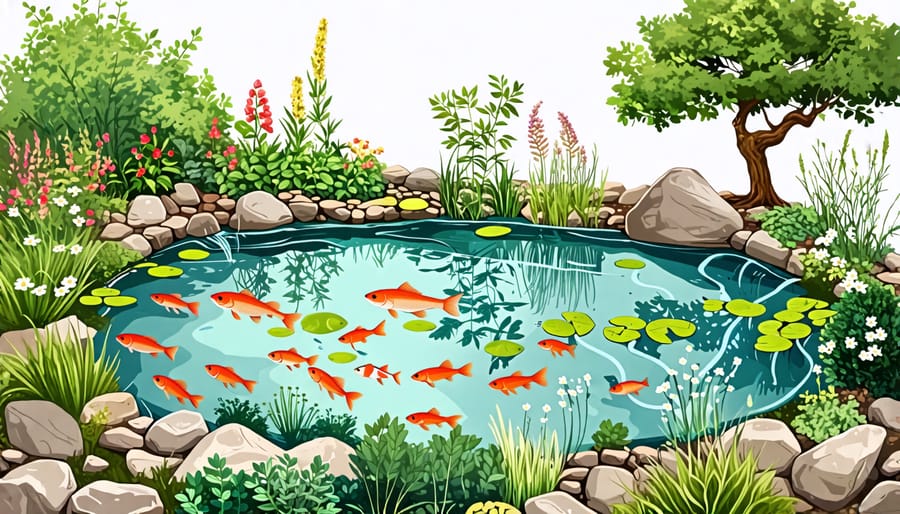
Create a Backyard Oasis: Dive into Ecosystem Pond Building Today
Transform your backyard into a thriving wildlife oasis by creating an ecosystem pond. Design your pond with natural elements like rocks, plants, and varying depths to mimic a natural habitat. Choose the right location that receives 4-6 hours of sunlight and is away from trees. Install a high-quality liner and filtration system to maintain crystal-clear water and a healthy environment for fish and plants. Stock your pond with a diverse array of native aquatic plants and fish species to establish a balanced, self-sustaining ecosystem.
Understanding Ecosystem Ponds
What is an Ecosystem Pond?
An ecosystem pond is a self-sustaining, balanced aquatic environment that mimics natural habitats. Unlike traditional ornamental ponds, ecosystem ponds rely on the harmonious interaction between plants, fish, bacteria, and other organisms to maintain water clarity and quality. By incorporating a diverse array of aquatic plants, beneficial bacteria, and carefully selected fish species, ecosystem ponds create a thriving ecosystem that requires minimal human intervention. The natural filtration provided by plants and bacteria eliminates the need for chemical treatments or frequent cleaning. Ecosystem ponds not only offer a stunning visual display but also attract wildlife, providing a tranquil oasis for both aquatic life and human enjoyment. With their emphasis on biodiversity and ecological balance, ecosystem ponds offer a rewarding and low-maintenance alternative to traditional water features.

Essential Elements of an Ecosystem Pond
To create a thriving ecosystem pond, several key elements must work together harmoniously. The foundation is a durable, flexible pond liner that holds water while allowing for natural contours. A reliable pump circulates water, preventing stagnation and supporting beneficial bacteria. Filtration, through biological or mechanical means, clarifies the water and maintains a healthy balance.
Aquatic plants are the heart of the ecosystem, providing oxygen, filtration, and habitats. Submerged plants like hornwort and anacharis oxygenate the water, while floating plants such as water lilies and lotus add beauty and shade. Marginal plants, including cattails and rushes, stabilize the edges and filter nutrients.
Fish bring life and motion to the pond. Koi and goldfish are popular choices, but smaller native species also thrive. Avoid overfeeding and maintain a balanced population to prevent waste buildup.
Rocks, gravel, and driftwood create natural structures and hiding spots for fish and beneficial organisms. Gravel beds support plant growth and house helpful bacteria.
Beneficial bacteria, nurtured by the pump and filtration, break down organic waste and keep the water clear. Regular water testing helps monitor the delicate ecosystem balance.
Finally, a skimmer or overflow system manages water levels and removes surface debris, while aeration through waterfalls or fountains enhances circulation and oxygenation.
By thoughtfully combining these essential elements—liner, pump, filtration, plants, fish, hardscapes, bacteria, and water management—you can create a self-sustaining ecosystem pond that brings beauty, tranquility, and a vibrant slice of nature to your outdoor space.

Planning Your Ecosystem Pond
Choosing the Right Location
Selecting the perfect spot for your ecosystem pond is crucial for its success. Consider factors like sunlight exposure, as most aquatic plants require at least six hours of direct sunlight daily. Avoid areas with excessive shade from buildings or trees. Ensure the location has a natural slope for proper drainage and is at least 10 feet away from trees to minimize leaf debris. Think about accessibility for maintenance and proximity to electrical outlets for powering pumps and filters. Choose a site that enhances your landscape design and provides a clear view from your favorite outdoor living spaces. Imagine the serenity of watching your pond from a patio or deck. Lastly, check local zoning regulations and utility lines before breaking ground. With careful planning, you’ll find the ideal location to create a thriving ecosystem pond that brings beauty and tranquility to your outdoor oasis.
Determining Pond Size and Shape
When it comes to determining the size and shape of your ecosystem pond, let your imagination be your guide! Consider the available space in your yard and envision how the pond will fit into the overall landscape design. A good rule of thumb is to make the pond proportional to the surrounding area – not too small or too large.
In terms of dimensions, a depth of at least 2 feet is recommended to provide a stable environment for fish and aquatic plants. The length and width can vary depending on your preferences and the space available. Remember, the larger the pond, the more stable the ecosystem will be.
Don’t be afraid to get creative with the shape of your pond! Irregular, organic shapes tend to look more natural and blend seamlessly with the landscape. Avoid perfect circles or squares, and instead opt for gentle curves and contours that mimic nature’s designs.
When deciding on the shape, consider the viewing angles from your home, patio, or deck. Think about where you’ll place seating areas and how you want the pond to be experienced from different vantage points. Incorporating different levels, such as shelves for plants or shallow areas for wading, can add visual interest and functionality to your pond.
As you plan the size and shape, don’t forget to leave room for additional features like waterfalls, streams, or bog areas. These elements can enhance the overall aesthetic and biological function of your ecosystem pond.
Designing Your Pond Landscape
When designing your pond landscape, think about how it will blend with your yard’s existing features and style. Consider the view from inside your home and key outdoor vantage points. Incorporate elements like rocks, driftwood, and plants to create a natural, organic look that complements your landscape. Use boulders and gravel to conceal the pond liner and create a seamless transition to the surrounding area. Planting a variety of aquatic plants, marginal plants, and moisture-loving perennials around the pond will soften the edges and provide a lush, inviting atmosphere. Don’t forget to add seating areas, pathways, and accent lighting to make your pond a welcoming retreat. With thoughtful design choices, your ecosystem pond will become a stunning focal point that enhances your outdoor living space and provides endless enjoyment for years to come.

Building Your Ecosystem Pond
Excavation and Liner Installation
Once you’ve mapped out your pond’s shape and size, it’s time to start digging! Use a sharp spade or excavator to carefully remove the soil, following your outline. As you dig, create shelves or tiers along the edges to support plants and provide shallower areas for wildlife. Aim for a depth of at least 18-24 inches in the center to ensure your pond won’t freeze solid in winter.
After excavating, remove any sharp rocks or debris that could puncture your liner. Then, lay down a protective underlayment, such as sand or specialized pond underlayment, to create a smooth, even base. Next, carefully unfold your pond liner, centering it over the hole. Gently push the liner into place, allowing it to conform to the contours of your pond. Avoid stretching the liner too tightly, as this can cause damage over time.
Secure the edges of the liner with heavy rocks or by digging a shallow trench and backfilling with soil. Trim any excess liner, leaving a generous 12-inch overhang to allow for settling and adjustments. Finally, fill your pond with water, and watch as your ecosystem pond takes shape before your eyes!
Adding Pond Equipment
Once your pond is excavated and lined, it’s time to add the essential equipment that will keep your ecosystem thriving. Start by placing the submersible pump at the deepest point of the pond, ensuring it’s level and stable. Connect the pump to the filter using durable, flexible tubing, following the manufacturer’s instructions carefully. Position the filter at the pond’s edge, making sure it’s easily accessible for maintenance.
Next, install any additional features like waterfalls, fountains, or spitters, connecting them to the pump and filter system according to the product guidelines. Be sure to test the flow and adjust as needed to achieve the desired effect.
Don’t forget to include a skimmer to remove surface debris, placing it near the pond’s edge where it can effectively capture floating leaves and other organic matter. Install any necessary plumbing to connect the skimmer to the filter system.
Finally, add any lighting fixtures, such as underwater lights or spotlights, to enhance your pond’s ambiance and extend your enjoyment into the evening hours. Be sure to use only weatherproof, outdoor-rated electrical components and follow all safety precautions when working with electricity near water.
With your equipment in place, you’re one step closer to enjoying the tranquil beauty of your very own ecosystem pond.
Introducing Plants and Fish
When selecting aquatic plants for your ecosystem pond, consider a mix of submerged, marginal, and floating varieties to create a balanced and natural-looking environment. Submerged plants like hornwort and anacharis provide oxygen and help maintain water clarity, while marginal plants such as cattails and rushes add vertical interest and help filter the water. Floating plants, including water lilies and lotus, provide shade and a stunning visual appeal.
When introducing fish to your pond, start with a few hardy species like goldfish or mosquitofish. These fish are adaptable to various conditions and help control mosquito larvae. As your pond matures, consider adding koi for their beautiful colors and patterns. Be mindful of the number of fish you add, as overcrowding can lead to poor water quality and stressed fish.
Gradually introduce new plants and fish to your pond, allowing time for the ecosystem to adjust. Monitor the water quality regularly and address any imbalances promptly. With careful selection and management, your aquatic plants and fish will thrive, creating a stunning and vibrant ecosystem pond that you can enjoy for years to come.
Maintaining Your Ecosystem Pond
Regular Maintenance Tasks
To keep your ecosystem pond thriving, regular maintenance is key. Start by cleaning the filters every few weeks, removing debris and rinsing them with pond water to preserve beneficial bacteria. Monitor water levels, topping off as needed to account for evaporation and ensure your pump stays submerged. Regularly skim fallen leaves and organic matter from the surface to prevent decay and nutrient buildup.
Prune aquatic plants as they grow to maintain balance and prevent overcrowding. Divide and repot potted plants annually. In fall, net the pond to catch leaves and trim back dying foliage. During winter, keep a hole in icy surfaces to allow gas exchange.
Test water quality monthly, checking pH, ammonia, and nitrite levels. Partial water changes can help maintain stability. Feed fish appropriately based on water temperature, and be vigilant for signs of illness.
Annually, drain and clean the pond, inspecting equipment and making repairs. With consistent upkeep, your ecosystem pond will remain a beautiful, low-maintenance oasis. Embrace the routine tasks as moments to connect with nature and appreciate the life thriving in your backyard paradise.
Seasonal Care Considerations
Your ecosystem pond’s maintenance needs change with the seasons. In spring, clear out debris, divide overgrown plants, and get the pump running again. Summer involves keeping water topped up, removing excess algae, and pruning plants. In fall, net the pond to catch fallen leaves and cut back dying foliage. For winter, either keep the pump running and maintain a hole in the ice, or shut it down and remove plants that can’t overwinter. Adjusting your care routine seasonally keeps your pond healthy and beautiful year-round.
Conclusion
Creating an ecosystem pond is a rewarding and enriching project that brings a slice of nature into your backyard. By following the steps outlined in this guide, you’ll be well on your way to establishing a thriving aquatic ecosystem that supports a diverse array of plants, fish, and wildlife.
Remember, the key to success lies in careful planning, thoughtful design, and regular maintenance. Take the time to understand your pond’s unique needs and tailor your approach accordingly. Don’t be afraid to experiment and make adjustments as you go – that’s part of the joy of water gardening!
As you embark on this journey, draw inspiration from the natural world around you. Observe how ecosystems function in the wild and strive to recreate those harmonious relationships in your own pond. With patience, dedication, and a love for the craft, you’ll soon find yourself immersed in a captivating underwater world right in your own backyard.
So what are you waiting for? Grab your tools, roll up your sleeves, and dive into the wonderful world of ecosystem ponds. The rewards – both aesthetic and ecological – are truly worth the effort. Happy pond building!
